I used to keep a pile of worn jeans in the corner, thinking they were too beat up to matter. A rainy afternoon and a dull TV show nudged me into trying a few simple experiments with those denim scraps.
Upcycled Denim Fabric Crafts quickly became a way to turn nostalgia into texture and color on a tiny scale.
There is something rewarding about turning faded blue and riveted seams into useful pieces. Upcycled Denim Fabric Crafts opened a window to playful experimenting with pockets, frayed edges, and unexpected combinations that feel cozy and familiar.
Patchwork denim tote with hidden pocket charm
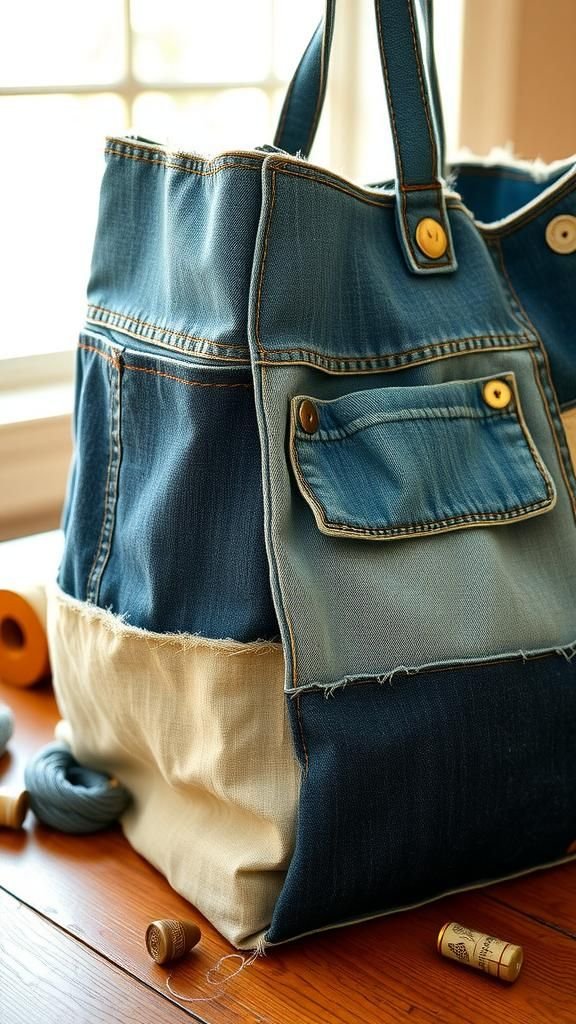
I remember pulling different jean panels together and feeling a tactile happiness at the mix of washes and weights. The tote carries a gentle weight from layered denim, and the seams whisper with a little fray.
Pockets from old jeans create unexpected nooks that peek out like secrets. The texture is hearty against the hand, and the aroma of worn cotton brings a quiet memory of outdoor afternoons.
Colors range from pale indigo to almost-black, and the stitches add a homey rhythm to the whole piece.
Steps
- Lay out denim panels in a pleasing arrangement, matching grain direction and pocket placements.
- Sew panels together along adjoining edges, finishing raw seams for durability.
- Add a pocket piece to the interior as a hidden compartment, aligning the opening toward the top.
- Attach handles made from folded denim strips and reinforce their anchors with bar tacks.
Cozy denim coasters with frayed edges
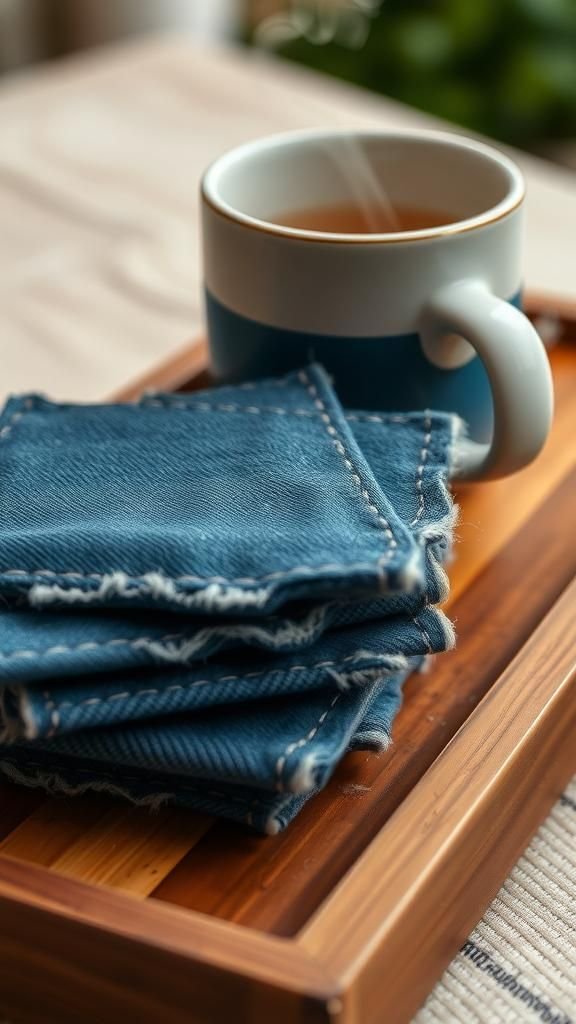
I kept a stack of these coasters by the kettle, enjoying the way their soft, worn surface soaked up little drips. The edges have a lived-in look, threads loosening into delicate fringe that fluffs when handled.
Each coaster feels pleasantly weighty and cool to the touch, the denim absorbing a warm ring from a ceramic mug with a faint scent of detergent and home. Color shifts across coasters give the set a casual rhythm, like old blues that have found new life at the table.
Steps
- Select matching square pieces from the same denim panels for a cohesive set.
- Place a layer of thin batting between two denim squares and stitch around the perimeter, leaving a small gap.
- Turn the coaster through the gap, press the edges flat, then topstitch close to the edge to close the gap.
- Create a frayed edge by gently pulling a few weft threads from the outer edge and trimming uneven ends.
Braided denim rug with faded blue charm

I once braided leftover jean legs into a circle and felt oddly proud at how the faded blues blended together. The rug has a firm, textured surface that is surprisingly comfortable under bare feet, and the braided ridges create a tactile pattern that invites brushing a hand across.
Each braid shows stitch lines and subtle wear, giving a gentle vintage feel. The scent of cotton and old sun lingers faintly, and the palette shifts like a well-traveled pair of jeans that has lived through many seasons.
Steps
- Cut long strips from denim panels, aiming for consistent widths from pant legs and seams.
- Braid three denim strips tightly and continue adding strips as the braid grows to maintain thickness.
- Coil the braid into a spiral, sewing through the layers at regular intervals to secure the shape.
- Finish the outer edge with additional stitches to flatten and stabilize the rug’s perimeter.
Denim pocket organizer for walls or doors
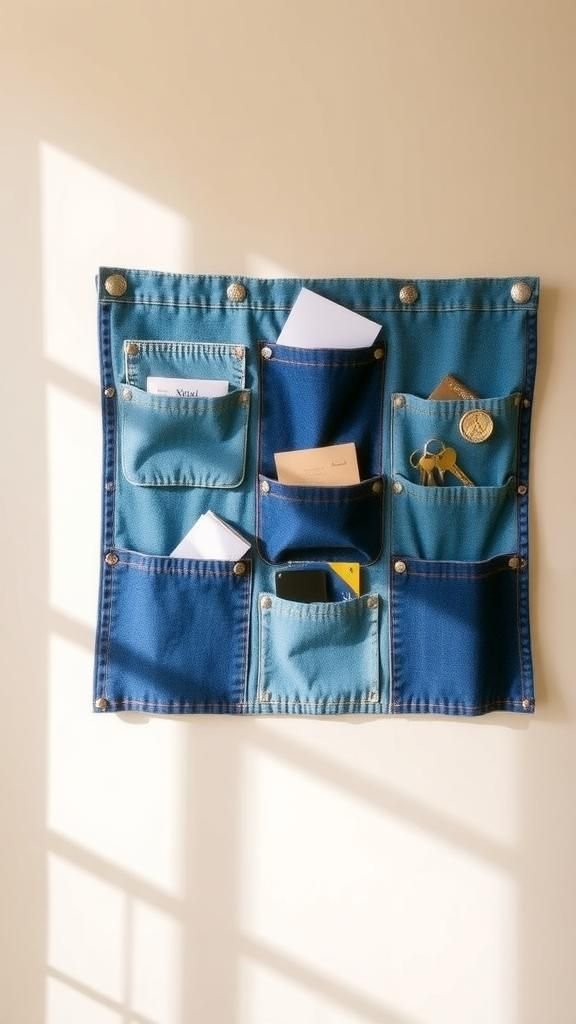
Hanging a panel of reused jean pockets beside the entryway felt like rediscovering little gardens of function. Each pocket offers a different depth and character, rivets catching the light and tiny seams folding into useful caves.
I liked how keys and scraps settled into pockets like small companions. The roughness of worn denim contrasts with smooth mail and glossy cards, creating a pleasing tactile interplay.
The colors vary across pockets, so the piece reads like a collage of everyday life, soft and familiar against a painted wall.
Steps
- Arrange a collection of jean pockets on a backing fabric or canvas, balancing sizes and washes.
- Stitch around each pocket base and sides to anchor them to the backing securely.
- Add a fabric loop or rod pocket across the top of the backing for hanging.
- Reinforce areas expected to carry weight with extra stitching or small patches.
Soft denim phone sleeve with stitched pocket detail

My phone slipped into this sleeve like it had found a small, familiar jacket. The denim surface is gently worn, with a slightly fuzzy edge where the fabric has softened.
Stitching lines create a subtle graphic across the front, and a tiny pocket borrowed from an old pair of jeans sits like an earnest little coin holder. The interior feels cushioned without being bulky, and the weight of the sleeve has a reassuring handfeel.
Light plays across faded indigo streaks, making each piece feel quietly personal.
Steps
- Trace the phone onto denim, leaving allowance around the outline for seam allowances.
- Cut two matching pieces and place them with right sides together, inserting thin batting between for padding if desired.
- Sew around the edges, leaving the top open, then turn right side out and press edges flat.
- Add a small pocket or flap to the front and topstitch around the perimeter for a finished look.
Zippered denim pouch with contrast stitching

Snagging a zipper from an old purse and pairing it with a denim scrap felt unexpectedly satisfying. The pouch carries a tidy sound when shaken, the zipper clicking with a small, bright rhythm.
The contrast stitching adds a pop that draws the eye along the seam, and the cotton interior keeps small items from rattling too loudly. The denim shows its history in faint crease lines and a softened hand.
Holding it, I appreciated how a simple closure changes the feeling of usefulness into gentle order.
Steps
- Cut two denim rectangles for the pouch body and a narrow strip for a tab if desired.
- Pin the zipper to the top edges of the denim pieces with right sides facing and sew along the zipper tape.
- Fold the pouch so right sides touch, sew around the sides and bottom, then turn through the zipper opening.
- Topstitch along the zipper edge for reinforcement and finish any raw seams inside.
Quilted denim throw with mixed pocket accents

Spreading this throw across the sofa felt like draping a collection of evenings over the room. Pockets become little islands of interest across the quilt face, some slightly glossy where coins once rested.
The quilted texture has a soft heft that invites settling in, and the seams form a shallow topography your fingers travel along. Each square retains traces of old stitches and occasional faint stains that read like memory.
The palette moves through warm indigo valleys and sun-faded highlights, offering a comfortable, lived-in look.
Steps
- Cut denim squares from assorted jeans and arrange them into a pleasing layout on the floor.
- Layer with batting and a backing fabric, pinning the layers together to prevent shifting.
- Quilt through all layers following a chosen pattern to add texture and stability.
- Bind the quilt edges with folded denim strips and finish the perimeter with topstitching.
Tiny denim key fob with stamped charm
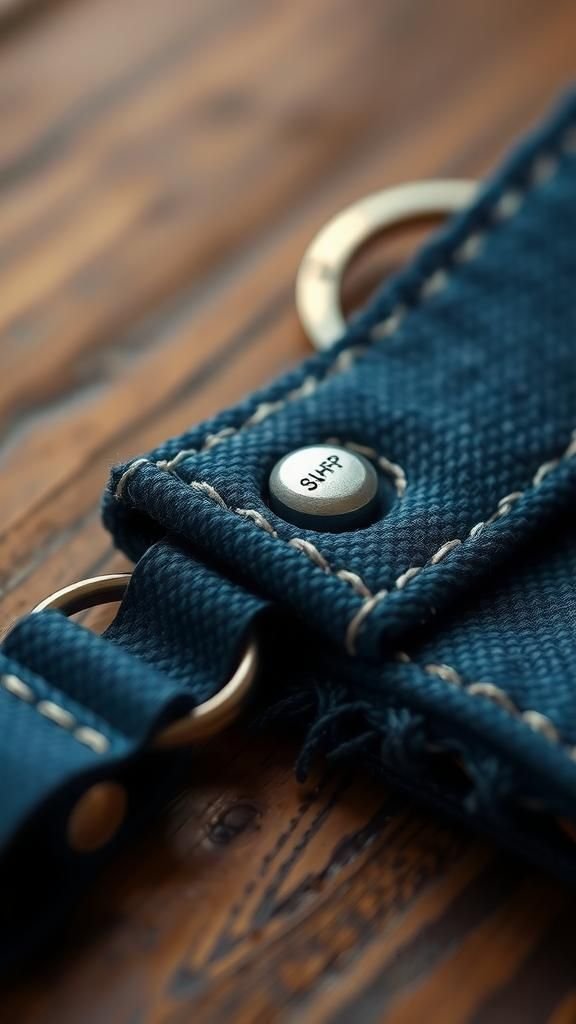
I looped a sliver of denim around a small ring and found it felt perfectly proportioned in hand. The tiny piece carries a little stiffness from folded layers and a gentle fray at the end.
A small stamped charm hangs with a quiet metallic glint, catching light when the keys jangle. That contrast between the soft cotton and cool metal feels pleasing, and the denim’s worn color picks up subtle highlights where fingertips had smoothed it.
It is an intimate, portable reminder of resourceful afternoons.
Steps
- Cut a narrow strip of denim and fold it around a key ring, overlapping slightly.
- Sew the overlapping area with tight stitches or secure with rivet hardware for durability.
- Add a small stamped metal charm to the ring for a decorative accent.
- Trim and lightly fray the tail end for a casual, worn look if desired.
Denim cuff bracelet with button closure
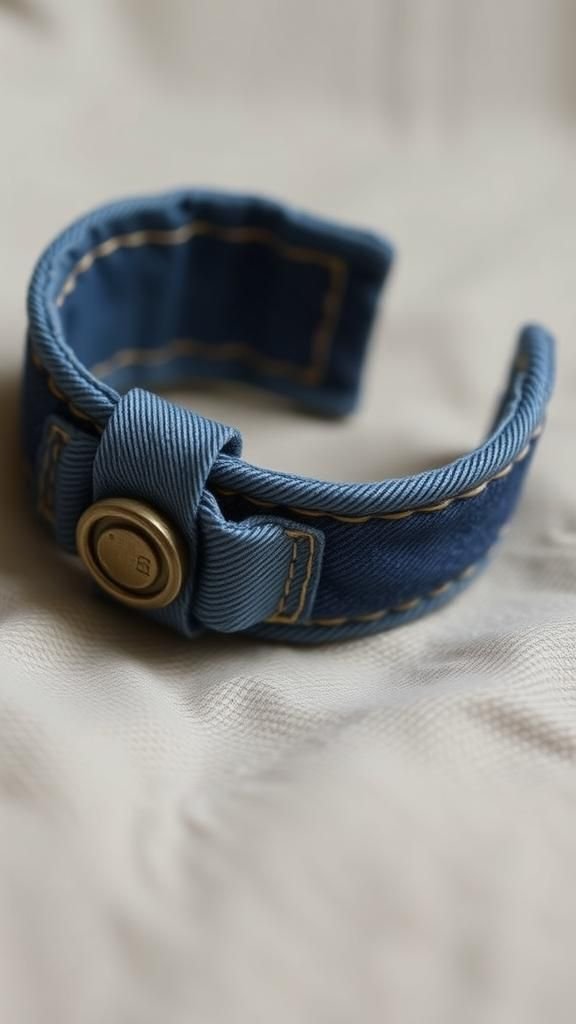
Wrapping this cuff around my wrist felt like borrowing a piece of old denim identity. The cotton has enough body to hold a curved shape while still flexing with movement.
The button closure offers a tactile click, and the worn edge softens against skin. Subtle stitching patterns trace along the band like tiny road maps, and the faded lines create a striped effect that reads as casual elegance.
Wearing it brought a small, quiet pleasure — a handcrafted accent that nods to recycled materials without shouting.
Steps
- Measure the wrist circumference and cut a denim strip with extra length for closure overlap.
- Fold edges inward and stitch to create smooth cuff edges, adding thin interfacing if more body is desired.
- Mark and attach a button on one end and a reinforced buttonhole or loop on the opposite end.
- Finish edges and add decorative topstitching to enhance the cuff’s visual lines.
Denim planter wrap with pocket for tools

Folding an old waistband around a plant pot brought an unexpectedly charming vibe to a sunny sill. The denim cradles the pot with a firm hug, and a pocket offers a tiny home for plant labels or a moisture meter.
Seams and belt loops peek out like architectural details, and the fabric soaks in sun with soft, mellow highlights. The roughened texture pairs well with the glossy leaves of a houseplant, creating a pleasant contrast between matte cotton and living greenery.
The result feels like a small, curated nook.
Steps
- Measure the pot’s circumference and cut a denim strip to wrap comfortably with overlap.
- Hem the top and bottom edges and add a pocket piece sewn onto the exterior.
- Secure the wrap around the pot with stitching, snaps, or a decorative tie at the overlap.
- Optionally add a small layer of waterproof material inside to protect the denim from soil moisture.
Denim wall collage with stitched motifs
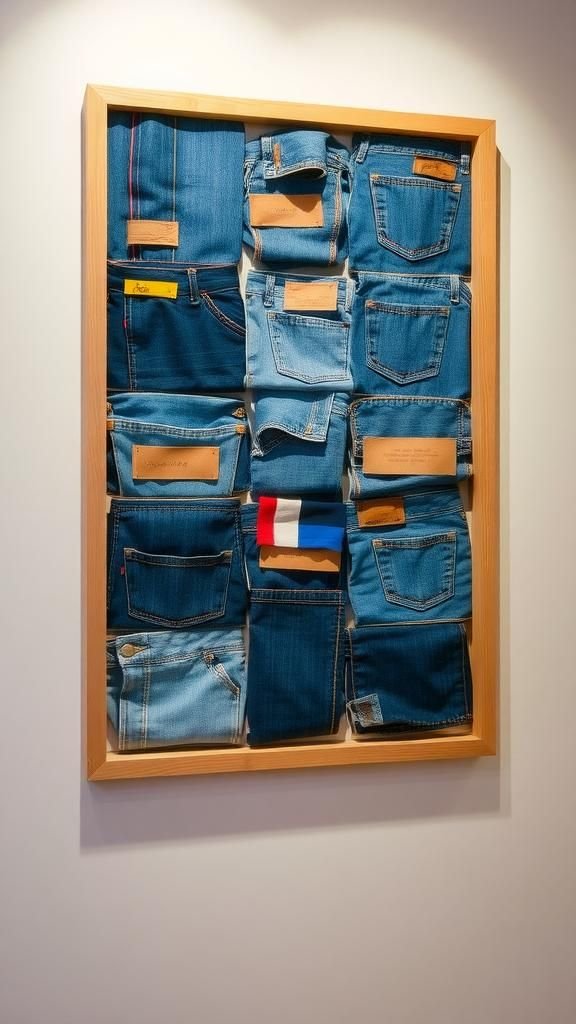
I pinned a collection of small denim patches to a canvas and enjoyed the way they behaved like stamps from different lives. Each patch felt alive with tiny marks, whiskers, and pale suns from washing cycles.
Hand stitching traced motifs across the pieces, adding a rhythmic thread language that felt quietly narrative. The surface invites peering close to catch faded labels and playful thread colors.
When hung, it reads like a textile map of errands and afternoons, resonant in a calm, textural way that warms a bare wall.
Steps
- Arrange denim scraps on a backing canvas until the composition feels balanced and dynamic.
- Pin or baste each patch in place, then stitch around patch edges to secure them permanently.
- Add embroidered motifs or hand-stitched lines to link patches and introduce subtle patterns.
- Finish the canvas edges and mount or frame for hanging.
Denim lampshade for warm, muted light

Replacing a torn shade with a denim cylinder changed the lamp’s voice into something softer. Light filters through the denim weave, warming to a gentle, diffused glow that feels cozy in the evening.
Seams create slight shadows, adding pattern to the emitted light, and frayed edges cast a delicate halo. Fingers brushing the shade pick up a faint cotton scent and the whisper of aged fabric.
The overall effect is quiet and inviting, turning a functional light into a tactile element that invites slowing down.
Steps
- Measure the lampshade height and circumference and cut a denim panel slightly larger for seam allowance.
- Adhere or stitch the denim panel around the existing lampshade frame, aligning seams neatly.
- Finish the top and bottom edges with folded denim strips or bias binding for a clean edge.
- Optionally add decorative topstitching or trim to emphasize seams and reduce light leak.
Wine bottle cozy wrapped in indigo denim

Sliding a wine bottle into a denim sleeve made the bottle feel dressed for a relaxed evening. The fabric brings a homespun texture to the glass, and the cuffed top shows a soft fray that catches light.
The denim muffles clinks and adds a casual, tactile layer when handing the bottle to someone. Subtle shade variations create a stripe as the bottle turns, and metal accents from old jean hardware peek out somewhere for a slightly rugged touch.
It feels like an invitation to slow conversation and close company.
Steps
- Measure the bottle height and circumference and cut a denim panel with overlap allowance.
- Sew a seam along the length to form a tube, finishing raw edges for durability.
- Hem the top edge or fold it over to create a cuff, and add a small tab or closure at the side.
- Slide the bottle into the cozy and adjust the fit by pressing seams flat.
Denim ottoman cover with textured patchwork
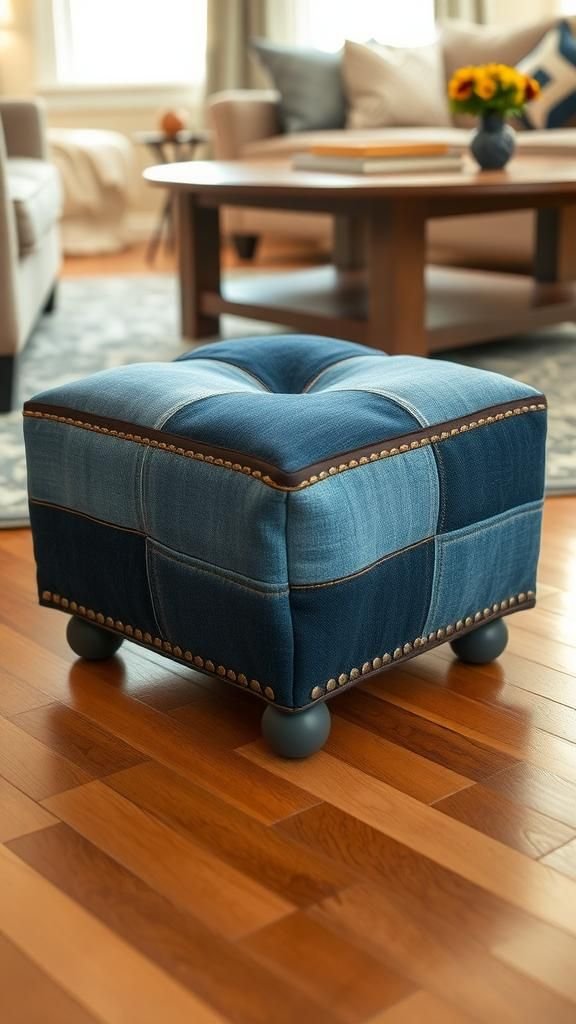
I reupholstered a small ottoman with denim pieces, and it quickly became a favored spot to rest feet. The surface is firm yet slightly forgiving, and patchwork seams create a quilted rhythm across the top.
The tactile contrast between worn thigh areas and darker hems gives each panel its own personality. Rivets and belt-loop remnants appear like small architectural touches.
The result blends practical sturdiness with a gentle softness that invites casual perching and quiet afternoons of reading or putting feet up after a busy day.
Steps
- Remove the ottoman cover, trace its dimensions onto denim panels, and add seam allowance.
- Piece denim patches together for the top surface, sewing panels with reinforced seams.
- Cut backing panels and assemble the cover, adding openings or fastenings to fit the ottoman securely.
- Refit the cover onto the ottoman, smoothing panels and finishing edges for a tailored look.
Pet bed wrapped in soft denim layers
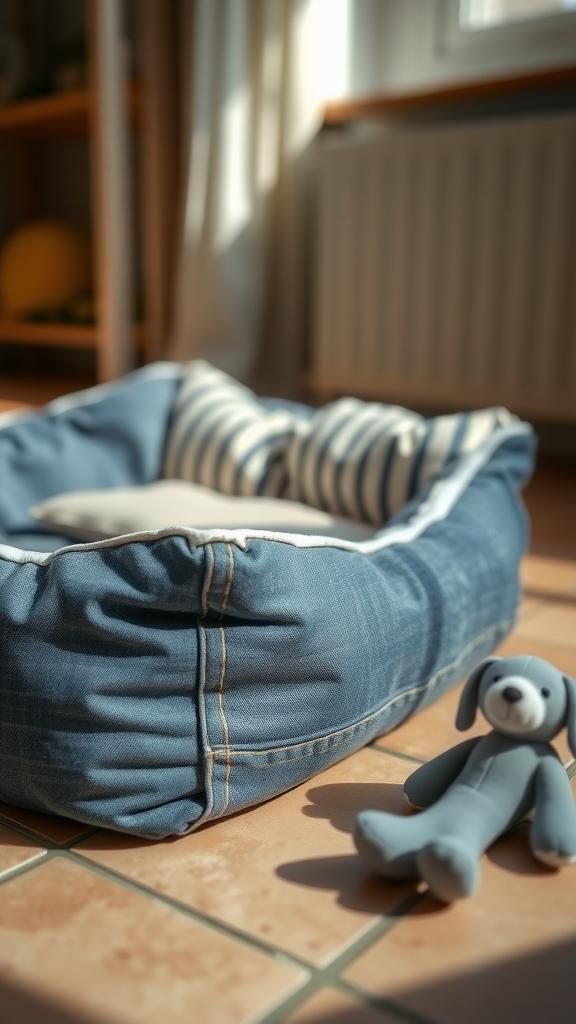
A low cushion swathed in layers of old jeans quickly became the favorite nap spot for a small dog. The denim offers a reassuringly familiar surface, warm from sun and softened by years of wear.
Seams and pocket flaps give the bed a playful, lived-in look that pets seem to appreciate, nestling into folds and leaning against padded edges. The fabric hides a little fur with ease and feels sturdy under claws while remaining comfortable.
Watching a curled-up pet breathe slowly on the denim is quietly satisfying.
Steps
- Cut an inner cushion to desired dimensions and sew a removable denim cover sized to slip over it.
- Arrange stronger denim pieces on high-wear areas and softer panels where the pet will rest most.
- Sew seams with reinforced stitching and add a zipper or flap to remove the cushion for washing.
- Fill the cushion with soft stuffing and close the cover securely for everyday use.
Denim apron with repurposed pocket collection
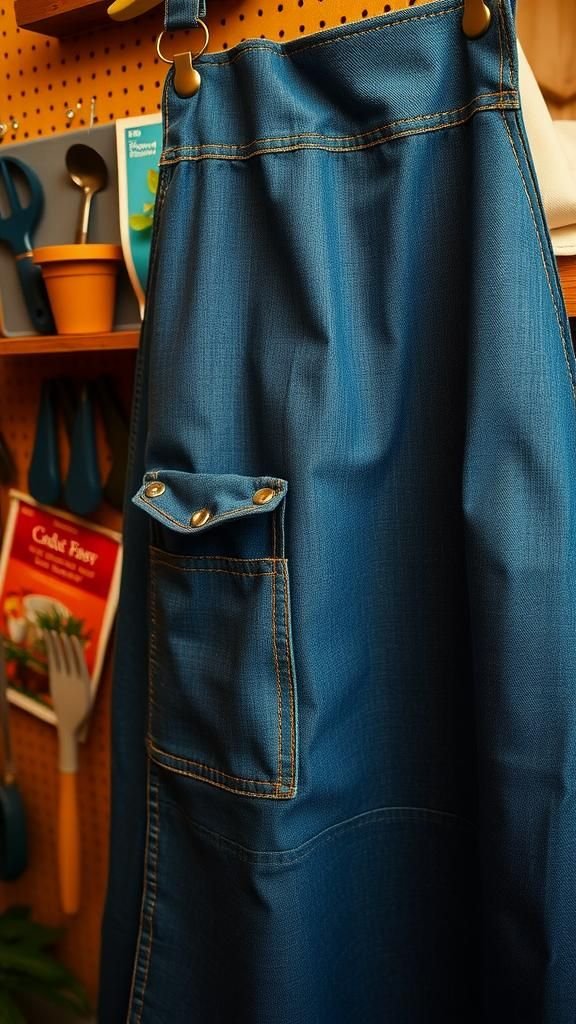
Putting on this apron felt like wearing a practical scrapbook of errands. The chest and hip pockets from different jeans create a convenient landscape for pens, a small notebook, or a gardening tag.
The denim resists stains more gently than lighter fabrics, absorbing life marks into a lived pattern rather than hiding them. Shoulder straps sit with a gentle weight that settles into place.
The texture feels substantial and comforting against the front of the body, and the mix of indigo tones gives the apron a familiar, casual character.
Steps
- Cut an apron body from a large denim panel and position assorted pockets where they will be most useful.
- Stitch each pocket securely to the apron body, reinforcing stress points with extra stitching.
- Prepare and attach shoulder straps and waist ties, ensuring comfortable length and secure anchors.
- Finish raw edges and add optional decorative stitching to personalize the apron.
Notebook cover sewn from sturdy denim scraps
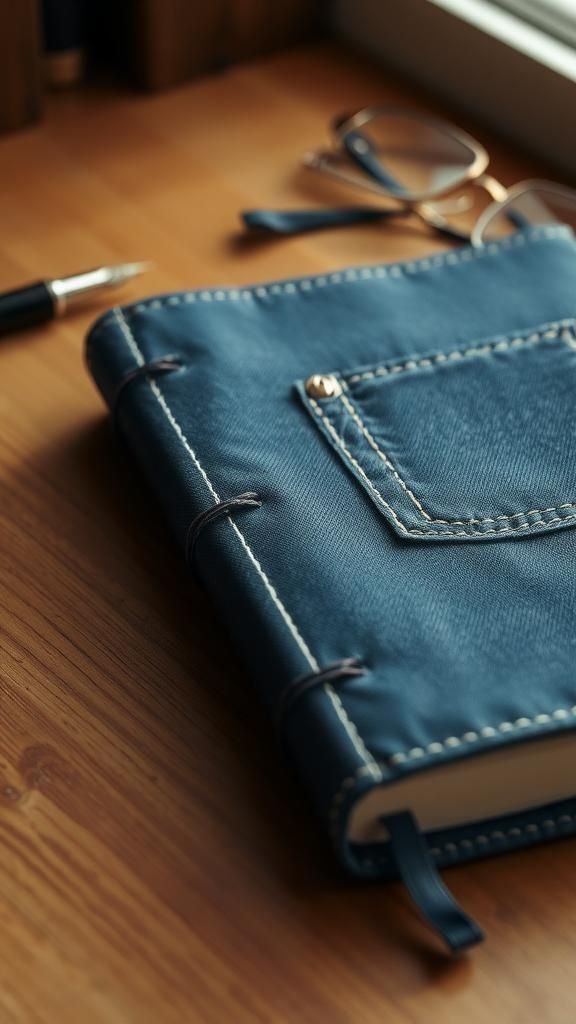
Slipping a notebook into a denim cover turned an ordinary journal into something tactile and private. The cover absorbs the faint aroma of coffee from my workspace and carries a reassuring thickness when hugged under the arm.
Seams and a small outer pocket hold receipts or a favorite receipt stub like a keepsake. The denim’s surface wears beautifully with handling, acquiring a soft sheen along the spine from repeated opening.
Its muted blues and occasional white whisker lines make the notebook feel companionable and ready for daily notes.
Steps
- Measure the notebook and cut denim panels to wrap around with allowance for seam and spine thickness.
- Sew the panels together to create a folded cover, adding a small pocket to the inside or outside if desired.
- Topstitch along the outer edges for a neat finish and to stabilize the fabric.
- Slide the notebook into the cover and press edges for a snug, finished fit.
Denim headband with soft frayed trim

Tucking a denim headband into my hair felt unexpectedly personal, the band holding a comfortable balance between structure and give. The fabric rests cool against skin, while the frayed trim adds a breezy, relaxed edge.
Subtle stitches trace along the band for a decorative accent, and the faded color reads like a quiet accessory that suits many outfits. When worn, the denim carries a faint scent of laundry and sunlight, blending into an everyday rhythm.
It feels like a small nod toward playful recycling.
Steps
- Cut a strip of denim to fit the head circumference with extra for overlap and seam allowance.
- Fold and sew the strip into a band, adding a soft lining for comfort if desired.
- Create a frayed or hemmed edge and finish the ends with neat stitching or a hidden seam.
- Press the band and test for comfortable fit, adjusting as necessary.
Denim garland strung with tiny pennants
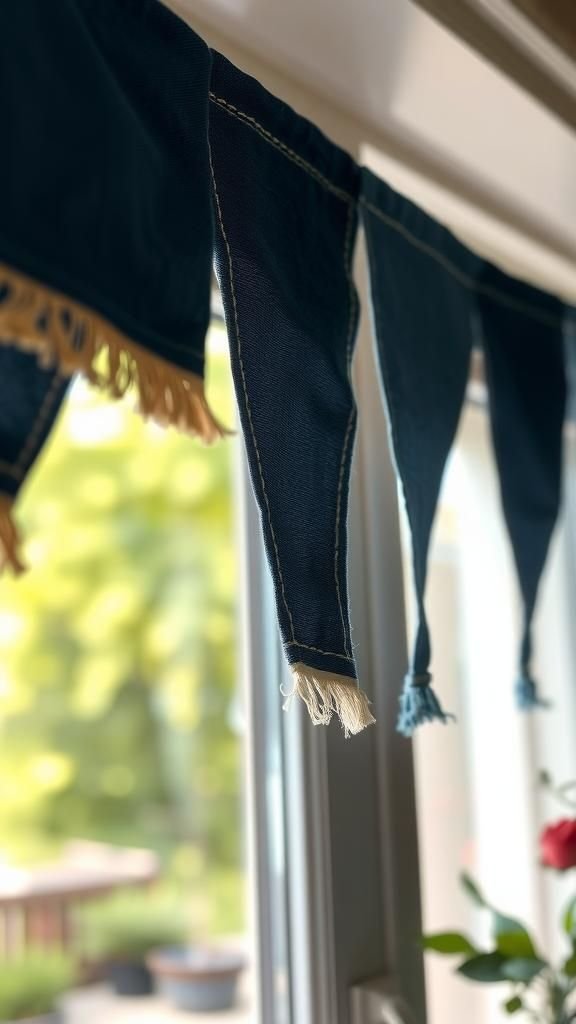
Stringing little denim pennants felt celebratory without fuss. Each triangle reads like a small flag, waving faintly with a gentle stiffness that keeps shape.
The garland gathers a range of indigo shades, and the edges show soft fray that dances in a slight breeze. Hanging it across a window or doorway brings a casual, handcrafted cheer to a room.
Light and shadow play across the stitched tops where the pennants meet the cord, creating a small rhythm that lifts the space without demanding attention.
Steps
- Cut small triangular pennants from denim scraps and finish edges by folding or allowing a controlled fray.
- Align and sew the top edges onto a length of sturdy cord or folded denim strip to form the garland.
- Space the pennants evenly and reinforce their attachment with extra stitching if needed.
- Hang the garland in a chosen spot and adjust spacing for visual balance.
Holiday stocking made from old denim jeans
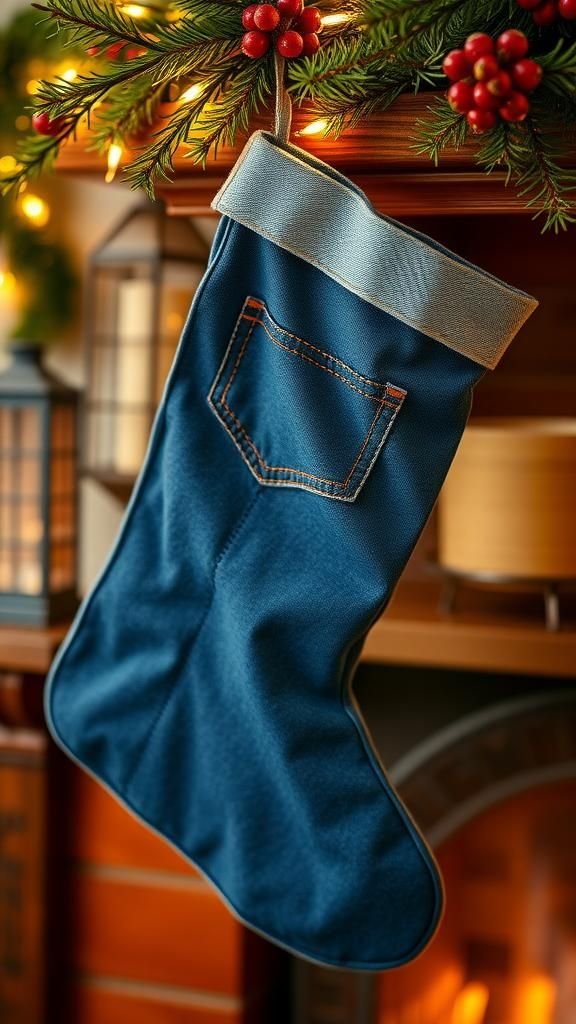
A denim stocking hung on the mantel felt homey against pine boughs. The weight of recycled denim lends the stocking a satisfying presence, and pocket details make delightful secret pouches for small surprises.
Faded knees and hem lines peek out as playful marks that tell a quiet story. The texture contrasts with soft velvet ornaments and shiny baubles, creating a rustic holiday mix.
The overall impression is cozy and rooted, like a seasonal nod to long-worn comfort layered into festive moments.
Steps
- Trace a stocking shape on denim folded in half and cut with allowance for seam and lining.
- Sew the stocking pieces together with right sides facing and add a soft lining for comfort.
- Attach a hanging loop and finish the cuff edge with a folded denim strip or decorative trim.
- Add pocket accents or stitched motifs for extra charm and personalization.
Small jewelry tray lined with denim scraps
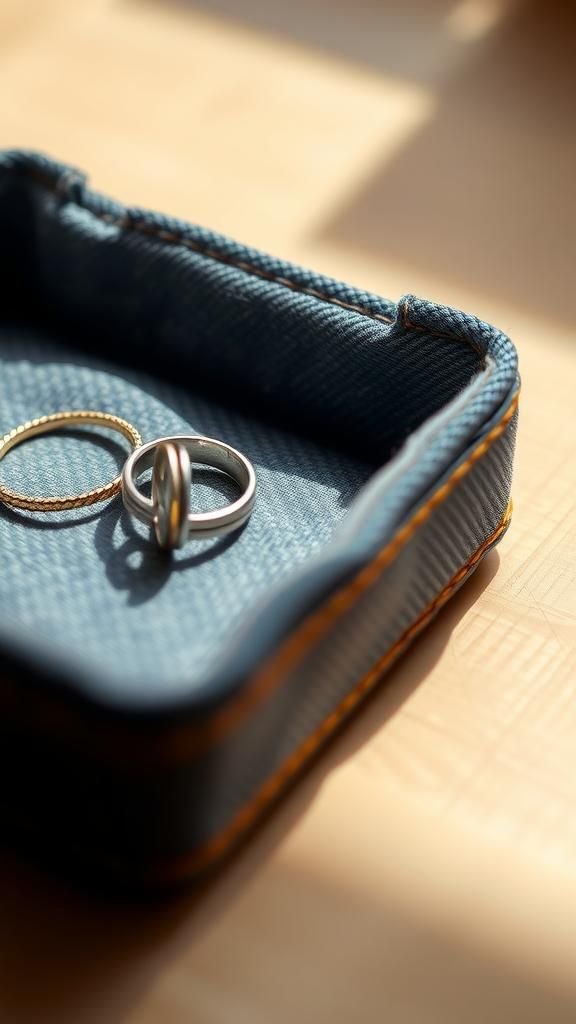
A shallow tray lined with denim felt like a gentle landing place for rings. The soft cotton nestles jewelry and mutes clinks, and the worn surface develops small impressions where pieces rest overnight.
The denim provides a neutral backdrop that makes metal tones stand out without glare. Seams at the tray corners introduce a subtle, handcrafted geometry, and the edges darken slightly with time as oils from hands mingle with the fabric.
It quickly became the kind of object that felt both useful and quietly intimate.
Steps
- Cut a base from a firm backing material and cover it with a denim square, wrapping and gluing or stitching the edges underneath.
- Create low walls around the base from folded denim strips or stitched fabric to form the tray’s sides.
- Securely stitch or adhere the walls to the base from the underside for a clean finish.
- Optionally add a thin layer of padding under the denim for extra softness.